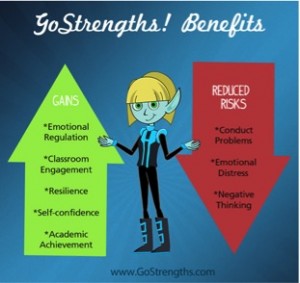GoStrengths for Individual Student Guidance

I’m sure most educators will agree that when they think back on those special times in their careers, where and when they made a difference, it was probably at the most challenging. For me, it was when disinterested students, who were mostly disruptive in other classes, didn’t want to leave my class when the bell rang. Keying in on those students, getting them to think positively about themselves and what they could do, just made my day—year—and career. In most cases, it changed more for the students. When students have the idea of self-worth, there are no boundaries—and that feeling carries over to other classrooms, the entire school environment, and to life.
I remember having guidance staff walk into my classes with these prepared posters once or twice a year—and sometimes when something awful occurred—and students needed an extra talk. I was usually left with those posters for wall hanging, and many times had to share them with my teaching team. The posters and talks, associated with them, usually involved some vocabulary and the same set of things to do for every student. I couldn’t help thinking that if students were all the same, maybe that would work, but my students were all different, and changing by the moment—and the day. What worked in that contained-half hour guidance talk didn’t carry over, or follow students—as they walked out my classroom door.
I love the idea of a school leader beginning each day with a positive opening over the intercom system. The best principals I’ve worked for did it. And teachers starting and ending each class along the same themes with simple statements like, “Remember to be kind to each other today,” followed by an example of what that kindness could be, makes sense, especially to the general school audience. It can make positive schoolwide culture change. But students need individual mentoring as well. Most districts have goals to team up educators with students as mentors, but many would like more than that. How can it be done in this digital world our students naturally live in?
I was recently asking that question during a visit to New York City at a company called GoStrengths. Its Chief Storyteller, Renee Jain said, “GoStrengths (http://www.gostrengths.com/) is an interactive program that educates teachers, mental health professionals, parents and youth on the reason behind their feelings and reactions, as well as providing concrete tools to effectively change negative behaviors into a positive sense of well-being.”
According to the GoStrengths folks, “One of the best ways to prevent bullying is to focus on the social environment of the school. Creating a mindset where school professionals feel comfortable intervening when they see bullying, and providing tools to help each child understand their thoughts and emotional reactions to stand up to bullying.”
So what is GoStrengths, and how does it work and help to individualize a student’s emotional needs? “GoStrengths.com is a training tool kitthat addresses how school professionals can teach life skills. The tool kit has individualized sessions for Professionals (GoAdultoids), Parents and Students (GoYouthlings). The same message is shared, however, it speaks to specific areas that each person is experiencing as they grow as or engage a Social Emotional Learner (SEL),” says Jain.
While we know that one thing can make a difference in a student’s school life and life outside of school, it most often is a combination of things. As educators we need to make those things as positive as we can, but also give students options—the tools—for how to handle difficulties each day and each moment. I think GoStrengths makes a good addition—offering the digital tools, and an animation approach 24/7 and 365 that students need today. It’s more powerful and lasting daily than a speech or presentation once or twice a year.
Tools and ideas to transform education. Sign up below.
More about GoStrengths:
Professionals/Parents gain techniques on how to assess a problem based on self thought and reactions; to bounce back after the problem has occurred (resilience); to create optimistic thinking for the future; to reduce the negative through resilience and increase the positive through learning skills to provide internal happiness.
From a Teacher and Mental Health Professional (Guidance Counselors, School Psychologists) perspective, GoStrengths is a very user-friendly program that emphasizes early intervention techniques to reduce two of the leading factors in SEL (social emotional learning) and academic failure for children: childhood anxiety/depression, and school bullying.
Visit GoStrengths at http://www.gostrengths.com/.
Ken Royal is a teacher/education and education technology blogger/reporter, video interviewer, podcaster, education event news commentator with 34 years of classroom/school and instructional technology experience. His teaching accomplishments include: 4-time district teacher of the year, Connecticut Middle School Teacher of the Year, and Bill and Melinda Gates award for Technology School of Excellence. Read more of Ken’s work at Royal Reports.
